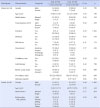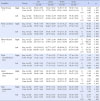Abstract
Purpose
The purpose of this study was to develop sleeve-type restraints and to compare the sleeve-type and conventional wrist restraints.
Methods
Forty four pairs of intensive care unit (ICU) patients and their families participated in the experiment. The nurses applied sleeve-type restraints to the patients in the experimental group, and wrist restraints to the control group. The trained research assistant measured ROMs, skin temperature, edema, and skin lesions of both upper extremities (UEs) before, 24, 48, and 72 hours after the restraints applied. The emotional response of family was measured 72 hours after the restraints applied. Thirty one ICU nurses evaluated the efficiency of both types of restraints.
Results
Compared to the control group, changes of ROMs, edema, and skin abrasions on both U/Es of the experimental group indicated a significant difference in physical side effects. The emotional response scores of the experimental group were significantly lower than those of the control group. The mean efficiency scores for the sleeve-type restraints were significantly higher than those for the wrist restraints.
Figures and Tables
References
1. American Nurses Association. ANA position statement: Reduction of patient restraint and seclusion in health care settings. 2012. 03. Retrieved May, 27, 2013. from http://www.nursingworld.org/restraintposition.
2. Benbenbishty J, Adam S, Endacott R. Physical restraint use in intensive care units across Europe: The PRICE study. Intensive Crit Care Nurs. 2010; 26:241–245.

3. Berzlanovich AM, Schöpfer J, Keil W. Deaths due to physical restraint. Dtsch Arztebl Int. 2012; 109:27–32.

4. Cho YA, Kim JS, Kim NR, Choi HJ, Cho JG, Lee HJ, et al. A study on the use of physical restraints in ICUs. J Korean Acad Adult Nurs. 2006; 18:543–552.
5. Chuang YH, Huang HT. Nurses' feelings and thoughts about using physical restraints on hospitalized older patients. J Clin Nurs. 2007; 16:486–494.

7. Evans D, Wood J, Lambert L. Patient injury and physical restraint devices: A systematic review. J Adv Nurs. 2003; 41:274–282.

9. Hofsø K, Coyer FM. Part 1. Chemical and physical restraints in the management of mechanically ventilated patients in the ICU: Contributing factors. Intensive Crit Care Nurs. 2007; 23:249–255. DOI: 10.1016/j.iccn.2007.04.003.

10. Kandeel NA, Attia AK. Physical restraints practice in adult intensive care units in Egypt. Nurs Health Sci. 2013; 15:79–85. DOI: 10.1111/nhs.12000.

11. Kim BY, Lee MJ, Kim HS, Choi SJ. Restraints development and the effects measured for university hospital ICU patients. Clin Nurs Res J. 2006; 9:7–30.
12. Kim MY, Park JS. A study on the application of physical restraints in intensive care units. J Korean Acad Fundam Nurs. 2010; 17:177–186.
13. Lai CK, Wong IY. Families' perspectives on the use of physical restraints. Contemp Nurse. 2008; 27:177–184.

14. Langley G, Schmollgruber S, Egan A. Restraints in intensive care units-a mixed method study. Intensive Crit Care Nurs. 2011; 27:67–75. DOI: 10.1016/j.iccn.2010.12.001.

15. Lee EN, Ha SJ, Kang J. Development and testing of an instrument to measure family's emotional response toward physically restrained patients. J Korean Acad Nurs. 2008; 38:629–638.

16. Lee JE, Gu MO. The development & effect of the elbow restraint on patients in the intensive care unit. J Korean Clin Nurs Res. 2011; 17:90–100.
17. Lee MM, Kim KS. Comparison of physical injury, emotional response and unplanned self-removal of medical devices according to use of physical restraint in intensive care unit patients. J Korean Clin Nurs Res. 2012; 18:296–306.
18. Ministry of Health & Welfare and Korea Institute for Healthcare Accreditation. Standards for healthcare accreditation. Seoul: Authors;2011.
19. Minnick AF, Mion LC, Johnson ME, Catrambone C, Leipzig R. Prevalence and variation of physical restraint use in acute care settings in the US. J Nurs Scholarsh. 2007; 9:30–37. DOI: 10.1111/j.1547-5069.2007.00140.x.

20. Möhler R, Richter T, Köpke S, Meyer G. Interventions for preventing and reducing the use of physical restraints in long-term geriatric care - a cochrane review. J Clin Nurs. 2012; 21:3070–3081. DOI: 10.1111/j.1365-2702.2012.04153.x.

21. Mun JS, Lee GN, Lee DS. Effect of a new developed physical restraint to reduce skin injury in intensive care units. J Korean Acad Fundam Nurs. 2011; 18:28–36.
22. Rakhmatullina M, Taub A, Jacob T. Morbidity and mortality associated with the utilization of restraints: A review of literature. Psychiatric Quarterly, Advanced Online Publication;2013. DOI: 10.1007/s11126-013-9262-6.
23. Swickhamer C, Colvig C, Chan SB. Restraint use in the elderly emergency department patient. J Emerg Med. 2013; 44:869–874.

24. The Joint Commission. Standards for behavioral health care. Oakbrook Terrace. IL: Author;2009.
25. Tolson D, Morley JE. Physical restraints: Abusive and harmful. J Am Med Dir Assoc. 2012; 13:311–313. DOI: 10.1016/j.jamda.2012.02.004.





 PDF
PDF ePub
ePub Citation
Citation Print
Print








 XML Download
XML Download